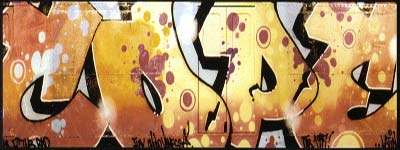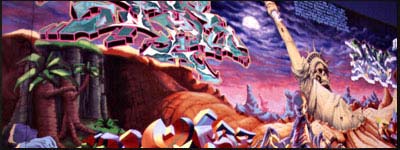Cholo Graffiti History
By Chaz Bojorquez
Los Angeles may have the longest history of street writing in the world. Some say that an earlier style of L.A. graffiti goes back to the 1930’s when the Latino shoeshine boys marked their names on the walls with daubers to stake out their spot on the sidewalk. Before the invention of the spray cans most L.A. graffiti was painted with paint and a brush, and the young men who lived by the Los Angeles River would use a stick and paint with tar seeping from the ground. Those tar tags still exist today and documents our graffiti history back to the 1940’s.
East L.A. graffiti has its own unique format called Placas (plaques) symbols of territorial street boundaries (could you explain a bit more?) Placas are a graffiti painted wall with the names of the gang and it's members, mostly painted on the limits or edges of their communities. They are pledges of allegiance to their neighborhood. Placas encourage gang strength and create an aura of exclusivity, and ‘always’ painted in black letters. It's typical writer would be a young boy, I have never heard of a girl writing Cholo. Its typeface was called Old English. This squarish, prestigious typeface was meant to present to the public a formal document. All the names from a gang were written in lines that were flushed left and right, or names were stacked line over line and centered.
Great care was taken to make them straight and clean. This layout or format is based on an ancient formula, about having a headline, body copy, and a logo. These three major building blocks of corporate and public advertising can also describe the type layout from ancient Sumerian clay tablets to the Constitution of the United States and the modern headline of the Los Angeles Times. The headline states the gang or street name, the body copy is your roll call list of everyone’s gang name, and the logo refers to the person who wrote it by adding his tag to the end of the Placa. This tradition of type, names and language has rarely deviated drastically and has been handed down from generation to generation, this style of writing we now call 'Cholo Graffiti'.
Cholo is much more than just graffiti, it's a lifestyle. It exist only in the southwest United States but the best graffiti comes from East Los Angeles. (what is Cholo? Could you explain to the unexperienced reader, trying to define this expression, the origins of the word?) this style of graffiti is written “by the neighborhood for the neighborhood”. To quote Joe Rodrigues "La Vida Loca, or the crazy life, is what they call the barrio gang experience". (maybe you should precise a bit more what type of neighborhood, that Chicano gangs are deeply rooted in their respective communities, and have existed for a long time, the cliques hierarchical sytem of generational subdivisions?) This is a major difference between Cholo and New York Wild Style graffiti. In Los Angeles the graffiti is based on culture and race, also in Cholo writing only one writer writes for the whole gang and you tag only within your own territory. In New York graffiti the emphasis is on being more of an individual not about ethic identity, where “getting up” all-city or all-state with your tag is more important than the group.
“Racism and poverty created the gangs, we had to protect ourselves”, a quote by an old time Zoot Suiter “El Chava” from Hoyo-Mara (Hoyo-Maravilla I suppose? yes ) gang in the 1940’s. In those times the Latino Zoot suiters (can you explain a bit more what is a Zoot Suiter?) were defining their Americanism. Zooters were not accepted by the Anglo-Americans as true citizens, where language (Spanish) and skin color segregated you to the bottom of society (why?). In the 1920's there were illegal mass deportations to Mexico of Mexican American citizens who were trying to unionize their labor. In Downtown Los Angeles my mother experienced the public beatings of Latino Zooters by the white U.S. servicemen during World War II. The U.S. sailors would followed the Latinos into their neighborhoods to attack them. To protect themselves they formed into gangs based on which neighborhood you lived in at that time. A sample of gang names like 18th Street, White Fence, Alpine Street, Clover Street and Avenues were actual locations and streets, they all still exist today.
Latino Zooters were swinging to their own styles, their hair done in big Pompadours and draped in tailor-made suits where their pants would start from under the armpits. They spoke “Calo”, their own language, a cool jive of half-English half-Spanish rhythms. The term applied loosely to the spoken slang of gypsies and bullfighters of Mexico and Spain used at that time. Out of this 1940's Zoot suiter experience came Low Riders (a parallel car culture to the Anglo Hot Rod scene of the 50's) (why?), gangster culture (Zoot Suiters from the 40's, Pachucos in the 50's, Cholos and Vatos of the 60-70's. All these names are the same people, today we call them Home Boys). Also the Zooter experience gave us tag names and finally a unique style of East Los Angeles graffiti, called Cholo. The Mexican American gangs were the first and Original Gangsters, hence the moniker 'O.G.'
We must give credit to the gangs for their steadfastness in keeping with the graffiti traditions. Cholo type is stronger today than ever before, and it has grown into an international influence. In the graffiti world painting 'battles' have taken place between Japanese calligraphers and East L.A. writers. This unique typeface has taken a very long journey from a European prototype to it’s use as symbols of pride for an American gangster culture. To have remained intact is formidable (you mean formally?), and its future usage is in the hands of the next generation.
 top
top
 home
home
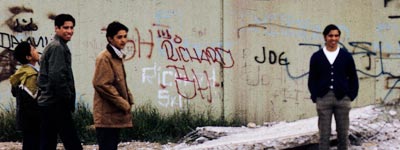
 HOME
HOME
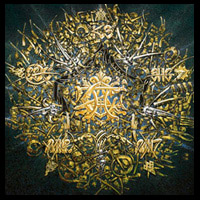
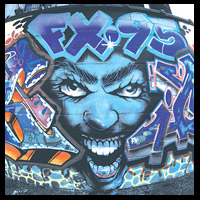
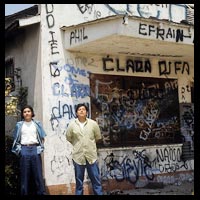
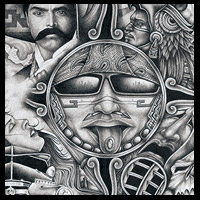
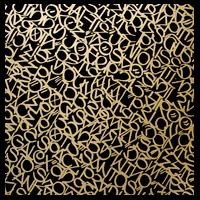
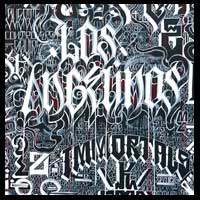
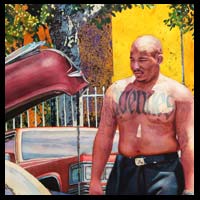
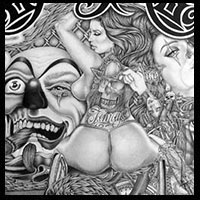
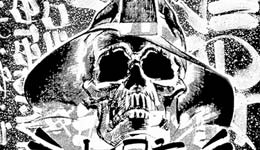
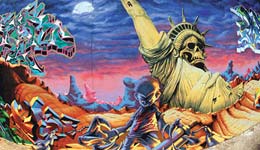
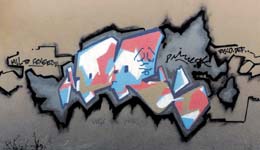
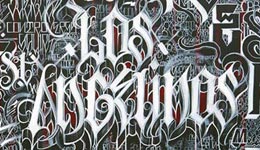
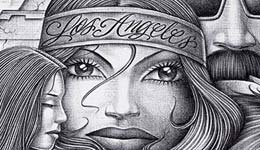
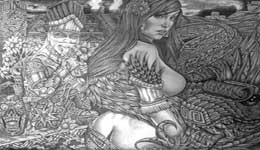

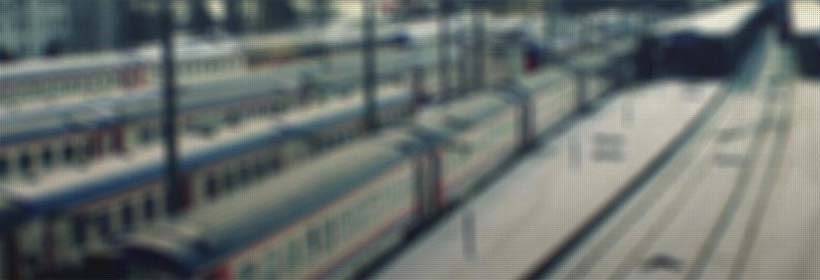
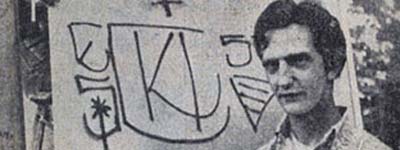


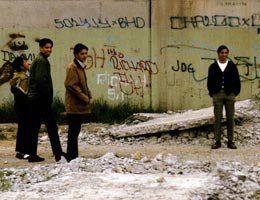
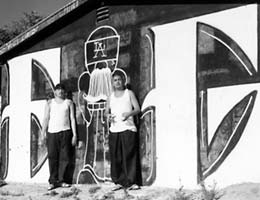
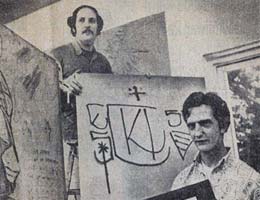 Display of graffiti at Pomona College of Art
Display of graffiti at Pomona College of Art
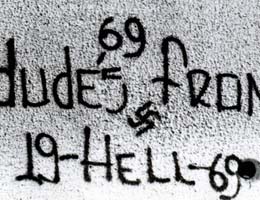 Image from the Bob Allikus Collection
Image from the Bob Allikus Collection
